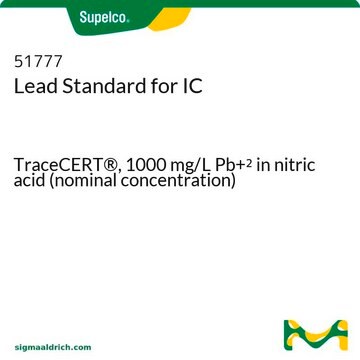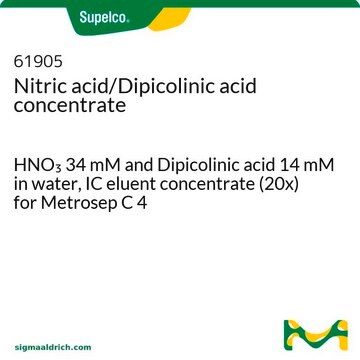8.00614
Pyridine-2,6-dicarboxylic acid
for synthesis
Sinonimo/i:
Pyridine-2,6-dicarboxylic acid, Dipicolinic acid
About This Item
Prodotti consigliati
Tensione di vapore
<0.01 hPa ( 20 °C)
Livello qualitativo
Saggio
≥98.0% (acidimetric)
Forma fisica
powder
Temp. autoaccensione
620 °C
Potenza
10500 mg/kg LD50, oral (Rat)
pH
2.0 (20 °C, 5 g/L in H2O)
Punto di fusione
248-255 °C
Solubilità
5 g/L
Densità bulk
700 kg/m3
Temperatura di conservazione
2-30°C
InChI
1S/C7H5NO4/c9-6(10)4-2-1-3-5(8-4)7(11)12/h1-3H,(H,9,10)(H,11,12)
WJJMNDUMQPNECX-UHFFFAOYSA-N
Categorie correlate
Applicazioni
- Adsorption of Cu(II) ions from aqueous solution using pyridine-2,6-dicarboxylic acid crosslinked chitosan as a green biopolymer adsorbent.: This research explores the efficiency of a green biopolymer, specifically chitosan crosslinked with pyridine-2,6-dicarboxylic acid, for the adsorption of copper ions from aqueous solutions, highlighting its potential for environmental cleanup and water treatment (Bisiriyu et al., 2020).
- Crystal structure of nonadentate tricompartmental ligand derived from pyridine-2,6-dicarboxylic acid: Spectroscopic, electrochemical and thermal investigations of its transition metal(II) complexes.: This article details the structural and functional characteristics of a complex ligand derived from pyridine-2,6-dicarboxylic acid, which could inform further research in coordination chemistry and material science (Vadavi et al., 2011).
- Pyridine-substituted oligopeptides as scaffolds for the assembly of multimetallic complexes: variation of chain length.: This research explores the use of pyridine-2,6-dicarboxylic acid in the construction of oligopeptide scaffolds for multimetallic complexes, relevant to the fields of molecular engineering and nanotechnology (Ohr et al., 2005).
- Comprehensive study of the luminescent properties and lifetimes of Eu(3+) and Tb(3+) chelated with various ligands in aqueous solutions: influence of the synergic agent, the surfactant and the energy level of the ligand triplet.: This study provides a thorough analysis of the luminescent behavior of lanthanide complexes with pyridine-2,6-dicarboxylic acid derivatives, significant for developing advanced photonic and electronic materials (Arnaud et al., 2003).
Risultati analitici
Identity (IR): conforms
Avvertenze
Danger
Indicazioni di pericolo
Classi di pericolo
Eye Dam. 1 - Skin Corr. 1B - STOT SE 3
Organi bersaglio
Respiratory system
Codice della classe di stoccaggio
8A - Combustible, corrosive hazardous materials
Classe di pericolosità dell'acqua (WGK)
WGK 3
Punto d’infiammabilità (°F)
370.4 °F - closed cup
Punto d’infiammabilità (°C)
188 °C - closed cup
Certificati d'analisi (COA)
Cerca il Certificati d'analisi (COA) digitando il numero di lotto/batch corrispondente. I numeri di lotto o di batch sono stampati sull'etichetta dei prodotti dopo la parola ‘Lotto’ o ‘Batch’.
Possiedi già questo prodotto?
I documenti relativi ai prodotti acquistati recentemente sono disponibili nell’Archivio dei documenti.
I clienti hanno visto anche
Il team dei nostri ricercatori vanta grande esperienza in tutte le aree della ricerca quali Life Science, scienza dei materiali, sintesi chimica, cromatografia, discipline analitiche, ecc..
Contatta l'Assistenza Tecnica.















